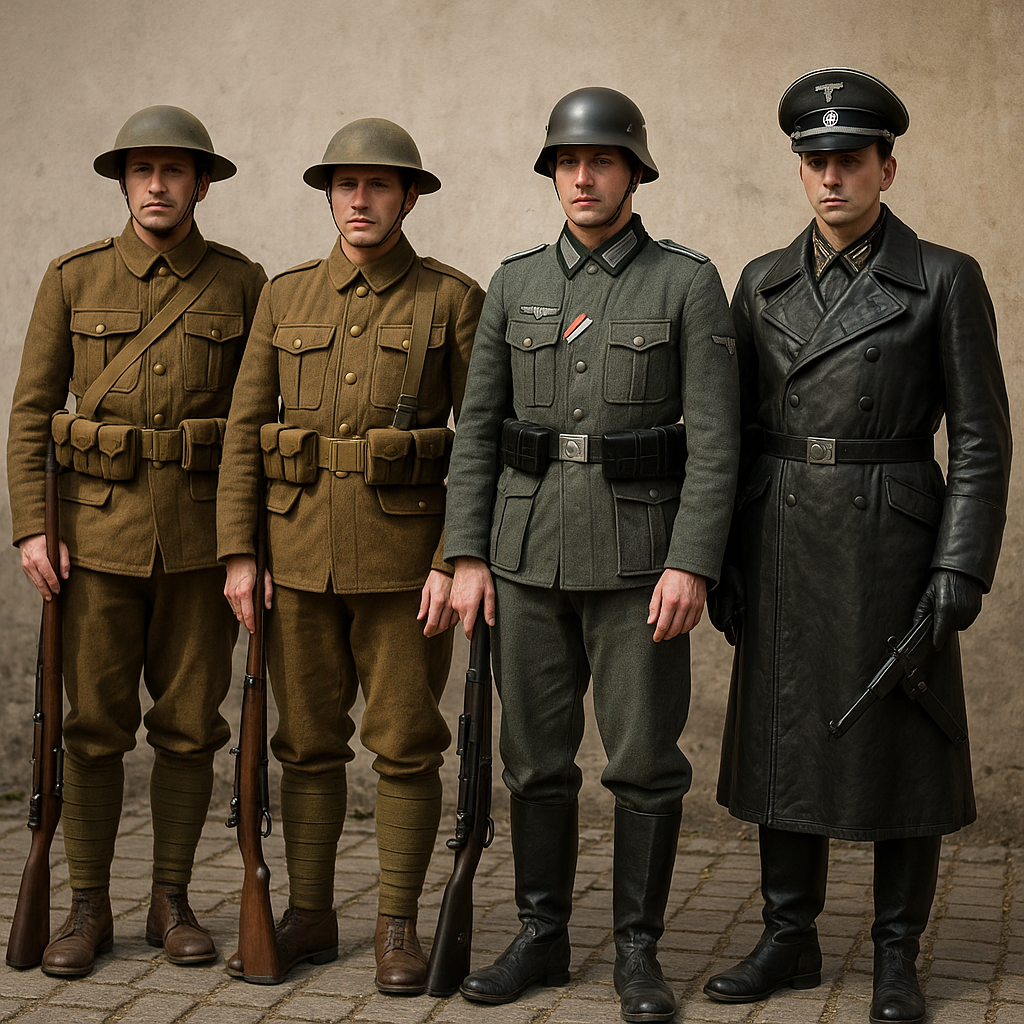
How to Assemble an Accurate WWI Reenactment Kit with Authentic Uniform Replicas
Published on Oct 01, 2025
The Ultimate Guide to WW1 Reenactment Equipment and Uniform Replicas
Ever wonder what it feels like to wear history?
According to the Historical Reenactment Society, interest in WW1 and WW2 reenactments has grown by over 65% in the last five years. More and more people are embracing history not just through books but by living it—and it all starts with the right gear.
Whether you’re a beginner stepping into the world of reenactment or a seasoned enthusiast looking to upgrade your kit, understanding WW1 reenactment equipment is essential. This guide will help you find authentic pieces, avoid common buying pitfalls, and stay current with the latest trends in historical uniforms.
Why WW1 and WW2 Reenactment Still Matters Today
WW1 and WW2 reenactment isn’t just cosplay—it’s living history. By accurately portraying soldiers, medics, or civilians, reenactors educate the public, preserve stories, and keep the memory of global conflicts alive.
Reenactments bring together:
- Educators and museum professionals
- Collectors and militaria hobbyists
- Veteran descendants preserving family legacies
- Film and theater productions
But to do this responsibly and authentically, your uniform and equipment matter. A lot.
Getting Started: Choosing the Right WW1 Reenactment Equipment
Start with the uniform: Authenticity Is Key
When building your reenactment persona, your uniform tells the story.
For WW1 uniform replicas, consider:
- Branch of service: British, German, French, American
- Rank and role: Infantryman, officer, medic
- Climate and campaign: Western Front vs. Gallipoli
Pro Tip: Always use period photographs or official army manuals for reference.
Where to Buy WW1 Uniform Replicas
- Trusted reenactment suppliers: e.g., Soldier of Fortune, Hessen Antique
- Online forums: Great War Forum, WW1 Reenactors group on Facebook
- eBay/Etsy: Be cautious; check seller reviews and ask for detailed photos
Essential WW1 Reenactment Equipment: What You Really Need
Start with the basics:
- Field tunic & trousers
- Puttees or gaiters
- Brodie helmet (British) or Pickelhaube/Stahlhelm (German)
- Reproduction boots (hobnailed for accuracy)
- Ammunition pouches and webbing
Optional but immersive extras:
- Gas mask bag
- Mess kit and canteen
- Wool blanket or shelter half
🔧 Avoid this common pitfall: Mixing WW2 gear with WW1 kits—while some items may look similar, they often have different stitching, materials, or insignia.
How WW2 Uniforms Fit Into the Reenactment Scene
If you're branching into WW2 reenactment, uniform accuracy becomes even more detailed, especially given the expanded range of forces and roles.
Popular picks include:
- WW2 uniform (U.S.): M1941 field jacket, wool trousers, and service boots
- German soldier costume: M40 tunic, jackboots, Y-straps, and reproduction gas mask canisters
- British WW2 infantry kit: Battledress, 1937 Pattern webbing, and Enfield pouches
🎖️ Collector’s Favorite: The WW2 leather trench coat, especially the German U-Boat or officer versions, is highly sought after in both reenactments and private collections.
Second World War Costumes vs. Authentic Gear: Know the Difference
Not all uniforms are created equal.
Category: Costume Authentic Reproduction
Material: Polyester blends, Wool, cotton duck
Durability: Low, High – field-ready
Details Simplified, generic, historically accurate down to the buttons
Price: $50–$100 $200–$600+
Best for Halloween, stage plays, Reenactments, and museums
If your goal is to honour historical accuracy, always go for high-quality reproductions, not cheap costumes.
Tips for Buying WW1 Uniform Replicas Online
Buying online? Here’s how to avoid disappointment:
✔️ Ask for detailed sizing charts
✔️ Look for wool weight and fabric type
✔️ Check for unit-specific features (e.g., color of piping, buttons)
✔️ Read customer reviews or ask fellow reenactors
✔️ Ensure return/exchange policies exist
🛑 Don’t fall for this: mass-produced “vintage-style” costumes labelled as “authentic”. If it’s under $100 and ships from a costume warehouse, it’s probably not reenactment-grade.
Trends in WW1 and WW2 Reenactment Gear (2025)
Reenactment gear continues to evolve with technology and community standards. Some trends include:
- 3D-printed replica parts: Helmets, badges, and even weapon grips
- Repro tailoring services: Custom-fit uniforms from historical patterns
- Women in reenactment: More inclusive kits representing medics, nurses, and resistance fighters
- Digital documentation: QR-coded tags linking uniforms to historical profiles
- Eco-conscious materials: Wool and cotton sourced sustainably
Common Pitfalls to Avoid in Historical Reenactment
💡 Be aware of these beginner mistakes:
- ❌ Wearing a WW2 leather trench coat in a WW1 event
- ❌ Mixing unit insignia from different armies
- ❌ Using modern items like sunglasses, plastic bottles, or phones in view
- ❌ Rushing to buy without research—build your kit gradually
Best Practices for Reenactors: Staying True to the Past
- 🔍 Research your unit thoroughly
- 📸 Reference original photos when assembling your look
- 🧼 Maintain your gear like a real soldier would: polish boots, clean metal parts, repair tears
- 🤝 Join local reenactment groups to learn from others and participate in events
Conclusion: Marching Toward the Past with WW1 Reenactment Equipment
Whether you're drawn by personal history, military heritage, or the thrill of authenticity, WW1 reenactment equipment opens a powerful gateway into the past.
By investing in the right gear—from WW1 uniform replicas to WW2 leather trench coats and Second World War costumes—you’re not just dressing up. You're helping preserve history, educate the public, and keep the stories of the past alive for future generations.
